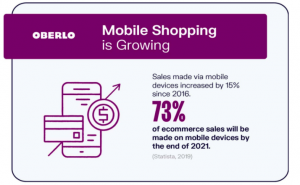This most certainly will be, how to put it… a rather unique Holiday season. One that will require unique ways of marketing and managing your digital platforms.
In this blog, as you probably already gathered, we’ll be talking about this year’s Holiday season sales and the determining factor in the success of retailers – Ecommerce – and the importance of “proper digital marketing”.
Let’s start with acknowledging the most popular annual sales extravaganzas – Black Friday, Cyber Monday (or Cyber Week for some), and Boxing Day; of which Black Friday traditionally has been the most well known and advertised.
Just so we have a benchmark, even though this year, it might be less relevant than normally, last year, Black Friday sales outperformed 2018. Adobe Analytics has reported that this has been a continually consistent trend reaching $7.4 billion last year in online sales alone, an increase of 16.2 % from the previous year. Furthermore, mobile devices brought in 65% of all ecommerce transactions.
Black Friday is most certainly popular and $7.4 billion is a big number, but Cyber Monday managed to surpass Black Friday, bringing in total sales of $9.4 billion in 2019, highlighting how important it is that your online game is strong. Given the situation, it should be no surprise that history will repeat itself. Or should we say, triple itself..?
 Image: Oberlo
Image: Oberlo
What’s Different?
It’s almost amusing looking back on some reports from 2019 saying that last year was the most historic year in retail sales. Just to give you an example: “This is the year that will go down in the history books as the tipping point between digital and real-world,” – Jon Reily…
Oh, Jon… how it has changed… And who would’ve known! But you were close, just a year later (2020) for very obvious reasons, ecommerce sales have not doubled, but tripled during the pandemic…
It has become a habit for most retailers to drop their prices well before the ”official” sales begin in the hope to sell more, and then just extend their sales for a bit. The expectation is that in 2020 sale-season will last even longer. Furthermore, the majority of big retailers, ones that mainly sold through brick-and-mortar store sales, are bringing their offline sales online this year too so the ecommerce space is going to be quite noisy.
How to handle it?
This year many businesses were forced to join the ecommerce sector to survive and keep trading. This in turn increased the competition in the ecommerce industry meaning businesses had to compete against more rivals and do more to stand out.
What does this mean to you? – You need to have a polished digital marketing strategy in place to win new customers and succeed in this year’s Holiday season. So let’s begin.
Ask yourself – Are you present? You need to put yourself out there – people need to know you exist! Which brings us to step number:
-
– Marketing, marketing, marketing!
Remember – smart advertising, smart promotions. Know your audience, what are they interested in, and where they spend their time online? All your marketing efforts should speak to your customer, sending a peaceful, comforting, and grounding message that unites. The businesses that will do this best will be able to stand out and compete in the increasingly saturated market. You will have to create some spectacular visuals, compelling copy, and most importantly, get your targeting right.
Depending on your target audience, there’s a plethora of advertising platforms to choose from. Our suggestion if you are struggling to pick one is to focus on where your customers are and build your presence on a few selected platforms gradually.
Just to give you an idea: in our experience, Pinterest, Instagram, and Facebook are brilliant for fashion businesses. But if you target over 40 demographics, you might want to focus more on Facebook instead of Instagram. For our gaming clients, we’ve had impressive results with Twitter, YouTube, and Facebook.



Photo: Client
The above is a good example of a mix of “lifestyle and product” photography, which works well for fashion. Always try to use lifestyle imagery that’s aspirational – especially in fashion, use models that reflect your audience and demographic.
When it comes to creative, don’t be afraid to test a few things. What resonates with one group of people might not work on others so make sure to have some variations!
Make some noise, put YOUR name out there!
Next. Step 2. Set it UP.
After you’ve done a brilliant job of getting your brand recognized and people clicking on your ad, consider how you are treating your customer when they land on your page? Is your online store delivering a personalized customer experience or is it just one of the many, many web stores someone lands on because they accidentally clicked on your sponsored content? Don’t advertise or bring your customer to a boxer short section when they’re interested in prom gowns. Very important, but so easy to make a detrimental mistake here – check your setup, check your URLs!
Step 3. Automation
When you get your customer to the website, make it seamless and automated, or in other words, sort out your backend. If you have chatbots on your site, that’s great but make sure you have automated your selling, shipping, and fulfillment so there are no hiccups when someone is giving you their hard-earned money.
Step 4. CX and path to Loyalty
These days it is so important that you have good after-sales support. Get someone answering the inquiries, comments on social media, and website – this is where you start working towards customer loyalty. To earn it, you’ve got to forget about the “sale done” concept. Give them the support and experience, give them a reason to trust you and they will come back.
Step 5. Evaluation
Speaking of coming back, you need to have the right procedures in place to measure the success of your efforts. Understand what went right and what went wrong, to learn from your successes and your mistakes so the next time you would be even better!
There are tons of platforms that can measure all your metrics. A classic example is Google Analytics, but there are others that can provide you with an in-depth overview of your customers’ journey through your platform.
The best way to measure the success of anything is to have clear KPIs. Know your targets and benchmarks – what are you measuring your success against?
We have listed some examples of KPIs you could consider as part of your evaluation.
Traffic Source – Where is your traffic coming from? Is it a social media network or perhaps it is GDN? Understanding where your customers are coming from will give you a better picture of where they spend most of their time online, and where you should focus your marketing efforts.
CTR – Are people clicking on your ads? Which one is performing the best and how is it different from others? Is it the visual that’s different or the copy? Assess which ads are working to understand what attracts your audience.
When you have understood your CTR, Click-Through to Conversion Rate Ratio is the next thing to look out for. How many of those click-throughs are actually converting to sales? What about the ones that didn’t convert, what stage of the sales funnel did they reach and what can you do to convert them?
And of course the bottom line – turnover and ROI. This is probably the ultimate guide on how effective your marketing is. Make sure you measure this. The formula to calculate ROI is as follows: Cost of Sales / Total Investment x 100 = ROI
With our clients, we also report on ROAS aka Return On Advertising Spend. In other words how much you gained from each dollar spent on advertising.
Of course, as with most things, the more the better, and the same goes with ROI, anything including and above 4:1 is a good ROI.
Bear in mind that the list of measurable KPIs is rather lengthy and these are just some examples you could include. Nevertheless, this will be specific to your business and your goals.
When all of your customers and audience is online, the businesses that will have a closer relationship with the customer will undoubtedly succeed, and some won’t even have to price their products at ridiculous discounts BECAUSE they’ve done their marketing right and have this relationship with the customer.
So if you’re going to take anything away from this blog, the most important thing you should understand is this – Your online presence has never been as vital as it is now, and yes, we mean to use the word vital because it is! If you don’t have it, people won’t know you exist. It’s not the same anymore, people won’t just randomly walk down the street and pop in, because they are curious and end up buying something. You got to be online, and be present, make as much noise as you can and engage with your customers and your prospects.
I know you’ve heard it too many times by now but I can’t say it enough, it will be different, the same strategies won’t work this year. You’ll have to put in some extra effort in digital marketing to get it done. So good luck to all the marketers and businesses out there!
Petra
Petra has 8+ years in digital marketing, working for companies like Square Enix, lastminute.com, Pinkberry, Blackberry, BRITA, and Fujitsu. Her expertise is mainly in paid media (social, display, Adwords), social media strategy and implementation, for which she has won a few awards as well.

